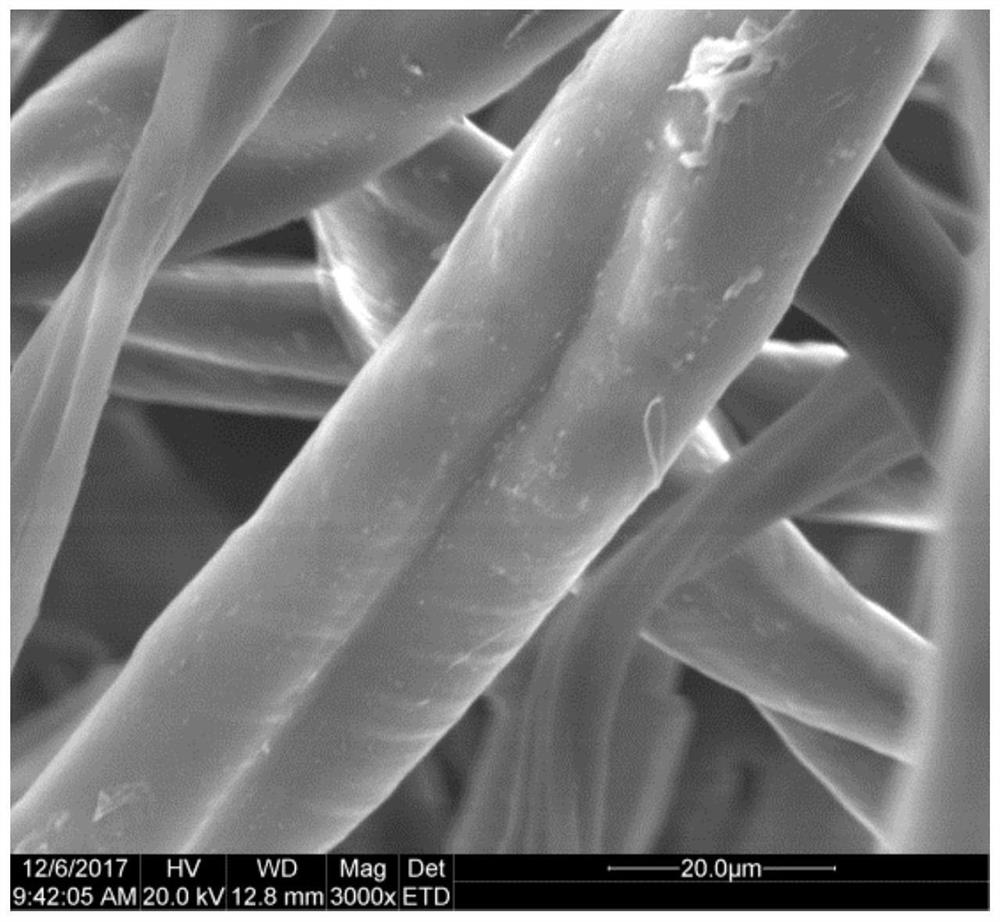A kind of antibacterial modification method of polymer material
A polymer material and modification technology, applied in the fields of plant fibers, organic chemistry, fiber processing, etc., can solve the problems of biological safety, easy leakage of nano-silver, and inability to form chemical bonds between polymers and nano-silver, so as to avoid Effects of Biosafety Issues
- Summary
- Abstract
- Description
- Claims
- Application Information
AI Technical Summary
Problems solved by technology
Method used
Image
Examples
Embodiment 1
[0061] 1. Synthesis of diazomethane
[0062] (1) Synthesis of compound 1
[0063] Weigh 4.42 g of anisole and dissolve in 50 mL of dichloromethane, then add 5.00 g of benzoyl chloride dropwise, and stir at room temperature for 24 hours after the addition is complete. After the reaction, it was washed with 50 mL of saturated brine, and washed three times. The lower organic phase was dried with about 10 g of anhydrous magnesium sulfate, filtered, and rotary steamed to obtain a crude product. The crude product was dissolved in dichloromethane, and then separated by column chromatography with a ratio of n-hexane: ethyl acetate = 4:1 to obtain a pure product (yield 30%).
[0064] (2) Synthesis of compound 2
[0065] Compound 1 (1 g) and 35 mL of absolute ethanol were added to a 100 mL round-bottomed flask. After completely dissolved, 80% hydrazine hydrate (2.19 g) was added, and 2 drops of acetic acid were added dropwise. The reaction time was 48 hours at 85°C. After the reaction is com...
Embodiment 2
[0076] 1. Synthesis of diazomethane
[0077] The same as in Example 1.
[0078] 2. Surface modification of nylon cloth
[0079] Dissolve 0.2g of compound 3 in 5mL of dichloromethane solution, add 2cm×2cm×0.1cm nylon cloth to fully soak the nylon cloth. Then, the methylene chloride was removed by rotary evaporation, so that compound 3 was uniformly adsorbed on the surface of the nylon cloth. Put it into a blast drying box and heat it to 120°C and keep it for 20 minutes. The color of nylon cloth changed from purple to yellow, indicating that the chemical modification was completed. Finally, the nylon cloth was washed 3 times with dichloromethane, 20 mL each time, and dried in a blast drying box after washing.
[0080] 3. Preparation of nano silver solution
[0081] The same as in Example 1.
[0082] 4. Preparation of antibacterial nylon cloth
[0083] The silver nanoparticle solution (5 mL) was dissolved in 15 mL of ethylene glycol solution. Then, the surface-modified nylon cloth was s...
Embodiment 3
[0085] 1. Synthesis of diazomethane
[0086] The same as in Example 1.
[0087] 2. Surface modification of polyurethane
[0088] Dissolve 0.2 g of compound 3 in 5 mL of cyclohexane solution and add it dropwise to the surface of the polyurethane film of 2 cm×2 cm×0.1 cm, and dry it with ear wash balls while dripping, so that compound 3 is uniformly adsorbed on the surface of the polyurethane film. Put it into a blast drying box and heat it to 120°C and keep it for 20 minutes. The color of the polyurethane changes from purple to yellow, indicating that the chemical modification is complete. Finally, the polyurethane was washed 3 times with cyclohexane, 20 mL each time, and dried in a blast drying box after washing.
[0089] 3. Preparation of nano silver solution
[0090] The same as in Example 1.
[0091] 4. Preparation of antibacterial polyurethane film
[0092] The silver nanoparticle solution (5 mL) was dissolved in 15 mL of ethylene glycol solution. Then, the surface-modified polyur...
PUM
| Property | Measurement | Unit |
|---|---|---|
| burnout rate | aaaaa | aaaaa |
| burnout rate | aaaaa | aaaaa |
Abstract
Description
Claims
Application Information
 Login to View More
Login to View More - R&D
- Intellectual Property
- Life Sciences
- Materials
- Tech Scout
- Unparalleled Data Quality
- Higher Quality Content
- 60% Fewer Hallucinations
Browse by: Latest US Patents, China's latest patents, Technical Efficacy Thesaurus, Application Domain, Technology Topic, Popular Technical Reports.
© 2025 PatSnap. All rights reserved.Legal|Privacy policy|Modern Slavery Act Transparency Statement|Sitemap|About US| Contact US: help@patsnap.com



